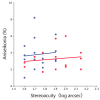Evaluation of Aniseikonia in Patients with Successfully Treated Anisometropic Amblyopia Using Spatial Aniseikonia Test
- PMID: 37297961
- PMCID: PMC10253754
- DOI: 10.3390/jcm12113766
Evaluation of Aniseikonia in Patients with Successfully Treated Anisometropic Amblyopia Using Spatial Aniseikonia Test
Abstract
Anisometropic amblyopia is decreased visual acuity in one eye, and treatment consists of wearing complete corrective spectacles. Aniseikonia occurs with complete correction of anisometropia using spectacles. Aniseikonia has been ignored when treating pediatric anisometropic amblyopia because of the prevailing belief that anisometropic symptoms are suppressed by adaptation. However, the conventional direct comparison method for evaluating aniseikonia significantly underestimates the degree of aniseikonia. This study investigated whether the adaptation occurs due to long-term anisometropic amblyopia treatment in patients who have had successful amblyopia treatment using a spatial aniseikonia test with high accuracy and repeatability compared with the conventional direct comparison method. The amount of aniseikonia was not significantly different between the patients with successful amblyopia treatment and individuals with anisometropia without a history of amblyopia. In both groups, the aniseikonia per 1.00 D of anisometropia and the aniseikonia per 1.00 mm of aniso-axial length were comparable. The repeatability of the amount of aniseikonia using the spatial aniseikonia test did not differ significantly between the two groups, indicating a high degree of agreement. These findings suggest that aniseikonia is not adapted to amblyopia treatment and that aniseikonia increases as the difference between spherical equivalent and axial length increases.
Keywords: amblyopia; aniseikonia; anisometropia; anisometropic amblyopia; binocular vision.
Conflict of interest statement
The funders had no role in the design of the study; in the collection, analyses, or interpretation of data; in the writing of the manuscript; or in the decision to publish the results.
Figures








Similar articles
-
Clinical Aniseikonia in Anisometropia and Amblyopia.Br Ir Orthopt J. 2020 Nov 20;16(1):44-54. doi: 10.22599/bioj.154. eCollection 2020. Br Ir Orthopt J. 2020. PMID: 34278210 Free PMC article.
-
Aniseikonia and anisometropia: implications for suppression and amblyopia.Clin Exp Optom. 2019 Nov;102(6):556-565. doi: 10.1111/cxo.12881. Epub 2019 Feb 21. Clin Exp Optom. 2019. PMID: 30791133 Review.
-
Aniseikonia in relation to strabismus, anisometropia and amblyopia.Binocul Vis Strabismus Q. 1999;14(3):203-7. Binocul Vis Strabismus Q. 1999. PMID: 10553113
-
Anisometropic Amblyopia: Interocular Contrast and Viewing Luminance Effects on Aniseikonia.Transl Vis Sci Technol. 2020 Feb 12;9(3):11. doi: 10.1167/tvst.9.3.11. Transl Vis Sci Technol. 2020. PMID: 32714637 Free PMC article.
-
The Role of Binocularity in Anisometropic Amblyopia.J Binocul Vis Ocul Motil. 2019 Oct-Dec;69(4):141-152. doi: 10.1080/2576117X.2019.1656034. Epub 2019 Sep 5. J Binocul Vis Ocul Motil. 2019. PMID: 31486743 Review.
References
-
- Ogle K.N. Researches in Binocular Vision. W. B. Saunders; Oxford, UK: 1950. pp. 243–336.
-
- Bannon R.E., Triller W. Aniseikonia—A Clinical Report Covering a Ten Year Period. Clin. Exp. Optom. 1944;27:296–309. doi: 10.1111/j.1444-0938.1944.tb00177.x. - DOI
Grants and funding
LinkOut - more resources
Full Text Sources

